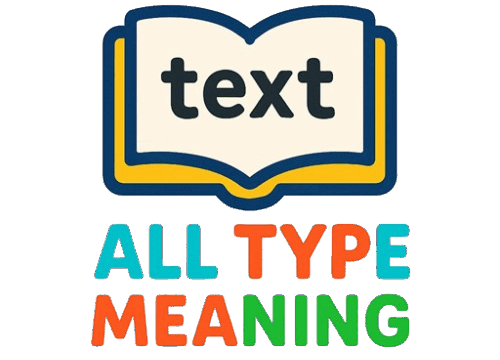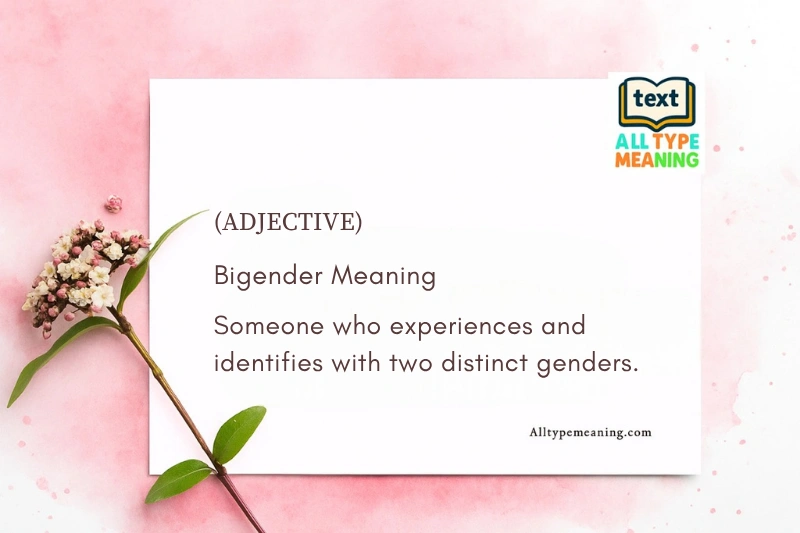Bigender Quick Stats Table
| Aspect | Details |
|---|---|
| Term | Bigender |
| Category | Gender Identity |
| First Known Use | Late 1990s (online communities) |
| Part of Speech | Adjective, Noun |
| Pronunciation | bye-JEN-der (IPA: /baɪˈdʒɛndər/) |
| Flag Colors | Pink, purple, blue, white |
| Common Pronouns | Varies (he/him, she/her, they/them, or alternating) |
What is Bigender Meaning? A Grammatical Overview
Bigender Definition: Bigender is a gender identity where a person experiences two distinct gender identities, either simultaneously or alternating between them. These two genders are most commonly male and female, but can be any combination of gender identities.
Pronunciation:
- Phonetic: bye-JEN-der
- IPA: /baɪˈdʒɛndər/
- Audio tip: Say “bye” (as in goodbye) + “gender”
Part of Speech:
- Adjective: “She is a bigender person.”
- Noun: “Bigender is a non-binary identity.”
Word Breakdown:
- Bi- (prefix): meaning “two” (from Latin)
- Gender (noun): social and personal identity as male, female, or other
Origin & Etymology: Where Did “Bigender” Come From?
The term “bigender” emerged in the late 1990s within online LGBTQ+ communities and discussion forums. It was created as people sought language to describe their experiences of identifying with two genders.
Historical Timeline:
- Pre-1990s: People experienced bigender identities but lacked specific terminology
- Late 1990s: Term “bigender” appears in online spaces
- Early 2000s: Increasing visibility in LGBTQ+ literature and resources
- 2010s-Present: Growing recognition and understanding in mainstream culture
Linguistic Roots: The word combines the Latin prefix “bi-” (two) with the English word “gender.” Similar to how “bilingual” means speaking two languages, “bigender” means identifying with two genders.
Bigender Meaning in Different Languages
| Language | Translation/Meaning | Example Sentence |
|---|---|---|
| English | A person with two gender identities | “Alex identifies as bigender.” |
| Hindi | द्विलिंगी (dvilingī) – दो लिंग पहचान | “वह द्विलिंगी व्यक्ति हैं” (They are bigender) |
| Tamil | இரட்டை பாலின அடையாளம் | “அவர் இரட்டை பாலின அடையாளம் கொண்டவர்” |
| Telugu | ద్విలింగ గుర్తింపు | “వారు ద్విలింగ గుర్తింపు కలిగి ఉన్నారు” |
| Spanish | Bigénero – dos identidades de género | “Ella es bigénero” |
Detailed Usage: Understanding Bigender in Context
1. As a Gender Identity
Bigender describes someone who experiences two gender identities. This can manifest in several ways:
Simultaneous Experience:
- Feeling both male and female at the same time
- Having a blended gender experience continuously
- Example: “I feel both masculine and feminine aspects of myself every day.”
Fluid/Alternating Experience:
- Switching between two genders at different times
- Gender shifts may be triggered by situation, mood, or occur naturally
- Example: “Some days I feel entirely male, other days completely female.”
2. Grammar Notes & Collocations
Common phrases and combinations:
- Bigender person (most common)
- Bigender identity
- Bigender individual
- Identify as bigender
- Bigender experience
3. Related Terminology
- Bigender flag: A pride flag with pink, purple, blue, and white stripes
- Bigender symbol: Often represented by combined ♂️♀️ symbols or custom designs
- Bigender pronouns: Varies by individual preference (he/him, she/her, they/them, or alternating)
Synonyms & Antonyms:
Related Terms
| Term | Meaning |
|---|---|
| Genderfluid | Gender identity that changes over time |
| Non-binary | Umbrella term for genders outside male/female binary |
| Androgynous | Having both masculine and feminine characteristics |
| Pangender | Experiencing many or all gender identities |
| Demigender | Partially identifying with a particular gender |
| Multigender | Having multiple gender identities |
| Genderqueer | Gender identity that doesn’t conform to conventional categories |
| Two-Spirit | Indigenous North American term for non-binary gender roles |
| Intergender | Gender identity between male and female |
| Ambigender | Experiencing two genders simultaneously without fluidity |
Contrasting Terms
| Term | Meaning |
|---|---|
| Monogender | Identifying with one single gender |
| Cisgender | Gender identity matches sex assigned at birth |
| Agender | Having no gender identity |
Words That Look Like “Bigender”
Be careful not to confuse these terms:
- Bisexual: Sexual orientation attracted to two or more genders (different from gender identity)
- Binary: Relating to two things; in gender, refers to male/female system
- Biracial: A person of two racial backgrounds (ethnicity, not gender)
Example Sentences: Bigender in Real Life
- Personal Identity: “After years of questioning, Jordan realized they were bigender and felt comfortable identifying as both male and female.”
- Pronouns: “The bigender person asked others to use both she/her and he/him pronouns interchangeably.”
- Experience: “As a bigender individual, Sam experiences days of strong masculine identity and days of strong feminine identity.”
- Community: “The LGBTQ+ support group welcomed bigender people and provided resources for understanding diverse gender identities.”
- Flag Display: “During Pride Month, many bigender individuals proudly displayed the pink, purple, blue, and white bigender flag.”
- Educational: “The student gave an informative presentation on what bigender means and why respecting all gender identities matters.”
- Self-Discovery: “Understanding the bigender definition helped Alex finally find words for feelings they’d experienced their whole life.”
Common Mistakes & Tips to Avoid Them
❌ Mistake #1: Confusing bigender with bisexual
- ✅ Correction: Bigender = gender identity (who you are)
- Bisexual = sexual orientation (who you’re attracted to)
❌ Mistake #2: Assuming bigender people must have two distinct personalities
- ✅ Correction: Bigender is about gender identity, not personality or mental health
❌ Mistake #3: Thinking bigender is a “phase” or confusion
- ✅ Correction: Bigender is a valid, real gender identity, not temporary confusion
❌ Mistake #4: Using wrong pronouns without asking
- ✅ Correction: Always ask bigender individuals their preferred pronouns—they vary by person
❌ Mistake #5: Spelling it as “bi-gender” or “by gender”
- ✅ Correction: The correct spelling is “bigender” (one word, no hyphen)
Cultural & Contextual Insight
Historical Context: Many cultures throughout history have recognized more than two genders. Indigenous cultures in North America had Two-Spirit people, South Asian cultures recognized Hijra, and various other societies acknowledged third, fourth, or fluid gender identities.
Modern Recognition:
- Growing legal recognition in documents and forms
- Increased representation in media and literature
- Academic research validating non-binary experiences
- Healthcare systems adapting to serve bigender individuals
Social Significance: Understanding bigender identity promotes:
- Inclusivity in schools, workplaces, and communities
- Mental health support for people exploring their identity
- Human rights recognition for all gender identities
- Education that reflects diverse human experiences
Tips to Remember & Learn
Memory Tricks:
- “Bi” = Two: Just like “bicycle” has two wheels, “bigender” involves two genders
- Think of a coin: Two sides (heads/tails) existing on one object—both are real, both are valid
- Remember the flag: Pink and blue (traditional gender colors) with purple (combination) and white (transition/neutrality)
Learning Strategy:
- Start by respecting people’s self-identification
- Ask questions politely when appropriate
- Read personal stories from bigender individuals
- Follow LGBTQ+ educational resources
- Practice using correct pronouns
Related Words / Word Families
Gender Identity Terms:
- Transgender, cisgender, non-binary
- Genderfluid, genderqueer, agender
- Gender expression, gender dysphoria
Prefix “Bi-” Words:
- Bilingual (two languages)
- Biannual (twice a year)
- Bipartisan (two political parties)
LGBTQ+ Community Terms:
- Pride, coming out, ally
- Pronouns, gender-affirming, inclusive
Reader Interaction: Share Your Thoughts
Understanding Bigender Meaning is a step toward building a more inclusive world. Whether you’re bigender yourself, know someone who is, or are learning for the first time, every bit of knowledge helps create acceptance.
Questions to Reflect On:
- How can you create more inclusive spaces in your community?
- What did you learn today that surprised you?
- How will you support bigender individuals in your life?
Take Action:
- Share this article with someone who might benefit
- Use correct pronouns and ask when unsure
- Educate others with kindness and patience
- Celebrate diversity in all its forms! 🎉
Related Expressions & Modern Usage
Common Phrases:
- “I identify as bigender”
- “Bigender representation matters”
- “Supporting bigender rights”
- “Bigender visibility”
Social Media Evolution: The term “bigender” has gained significant traction on platforms like TikTok, Instagram, and Twitter, where young people share their experiences and educate others. Hashtags like #bigender, #bigenerdpride, and #genderidentity have millions of views, creating supportive communities worldwide.
Academic Recognition: Universities and research institutions now include bigender in gender studies curricula, and psychological associations recognize it as a valid identity in their professional guidelines.
Conclusion:
The Bigender Meaning refers to someone who identifies with two genders, either at the same time or at different times, usually including both male and female traits. The term started in the late 1990s within online LGBTQ+ communities and has become more recognized in education, media, and social conversations.
Understanding bigender fosters inclusivity, respect, and clear communication about gender diversity. This article outlines its meaning, provides examples, discusses pronouns, related terms, and its use in various cultures, assisting students, professionals, and language learners in appreciating and supporting diverse gender identities effectively. Explore our ultimate guide to the Leniency Meaning.
Frequently Asked Questions
Q1: What does bigender meaning in simple terms?
A: Bigender means identifying with two genders, either simultaneously or alternating between them.
Q2: Is bigender the same as being transgender?
A: Bigender falls under the transgender umbrella, but not all bigender people use the term “transgender” for themselves.
Q3: What pronouns do bigender people use?
A: It varies by individual—he/him, she/her, they/them, or alternating pronouns. Always ask politely rather than assuming.
Q4: Can someone be bigender and bisexual?
A: Yes! Bigender is gender identity (who you are), while bisexual is sexual orientation (who you’re attracted to).
Q5: How do I know if I’m bigender?
A: If you consistently identify with two genders simultaneously or alternating, you might be bigender. Only you can determine your identity.

